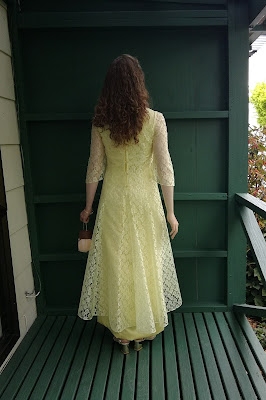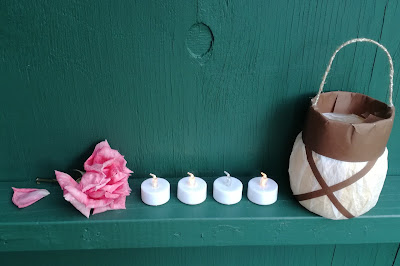Tragically, my city no longer has a fabric store. Here's how I get over that hurdle when I need coordinating material to make an outfit. Instead of buying new fabric yardage, when I shop for an outfit at a secondhand store, I source fabric from other garments on the rack.
I look for one main piece in a fabric or colour I like. Any adult size will do, usually the larger the better. Next I look for other garments in fabric that will coordinate with my first piece. I then rearrange the fabric from these garments to create one outfit or dress.
Hummingbird Blue
When I spotted this hummingbird fabric, I immediately loved it and longed to wear it. Given that it was assembled as a spliced and skimpy jumpsuit, it would take some creativity to make it modest and wearable. But I was willing to try, because I loved the fabric so much.
Now I knew I was looking for blue. I hunted around the racks and to my delight found a floor-length taffeta skirt in a shade that matched the hummingbird beautifully. The skirt was far to big for me, but this made me even happier - I had more fabric to work with.
Then I found a chiffon tunic with a knit camisole attached to it. The tunic was too big and too revealing to wear as it was, but I really liked the drape of it and it was in a shade that toned with the other items.
Concerned about cool evenings in a sleeveless dress, I was happy to find an elegant cardigan, although this too had a fit issue.
Now I had my ensemble, but they needed assembling!
Deconstruct the Skirt
Step 1. Unpick the skirt waistband and zipper. Sew up the seam where the zipper was.
Reconstruct the Skirt
Step 2. Detach the camisole from the tunic. Sew the skirt waist to the camisole, creating a tank dress. (Before stitching them together, I added a short skirt lining using a remnant from my stash - lined skirts feel so comfortable to wear!)
Reconstruct the Jumpsuit
Step 3. Unpick the leg/crotch seam of the hummingbird jumper suit and cut away the scoop of the crotch extension, leaving a straight edge down the back and front. Unpick the hem a little on each side of the raw edges to give you room to work. Sew the fronts together and the backs together, then rehem the bottom edge. Now the jumpsuit is a tunic.
Fix Fit Issues
Step 4. The hummingbird tunic still had some gaping areas with keyholes front and back, and low armholes. These were easily fixed with some pinch and stitch action.
Step 5. The fitted chiffon tunic sat too low on my bosom, making puckers in odd places and allowing for more movement than felt safe for my modesty. The armholes were also too large. Because the fabric was so light, I was able to pinch the shoulder seam up without creating too much bulk. This improved the fit at the bust and front neckline, and reduced the armholes. I arranged the sleeve gathers to please me, then handstitched them in place at the shoulder.
Step 6. The knit viscose cardigan was designed for a lady with longer arm scye and more bosom than I have (this is also why the chiffon tunic didn't fit me). I gathered the extra fabric into a series of pleats and stitched them by hand, turning them into a style feature that encourages me to wear my hair up so they can be seen.
Styling Choices
An alternative might have been to make a long dress by sewing the hummingbird tunic to the taffeta skirt, but this way the soft drape of the delicate tunic is retained, and the outfit is more flexible. I can change the look by changing the style of tunic. I can also wear a tunic over a different dress or with wide-leg trousers.
I hope you've seen something beautiful and inspiring here today.
Look out for more Boutique Narelle posts detailing liberating modest fashion techniques.
Fiat lux!

































































